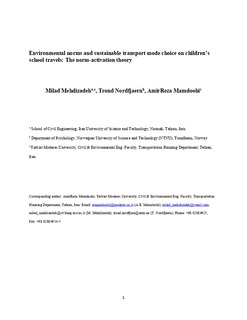| dc.description.abstract | The increasing use of car in developing countries is an important reason for traffic congestion and pollution. Using a car may partly reflect a normative choice, but the majority of previous studies that used the Norm-Activation Model (NAM) to study pro-environmental transport behavior were conducted among the general public in high income and developed countries in Europe and Northern America. The present research aimed to examine the causal chain of the NAM theory and the role of the NAM dimensions as well as socio-demographic and situational characteristics for parental sustainable transport mode choice on their children’s school travels in an Iranian context. Among the three core NAM dimensions, awareness of consequences refers to how aware people are of the negative consequences of car use. Ascription of responsibility refers to whether individuals perceive themselves to be personally responsible for the consequences of car use, and personal norms are defined as a moral personal obligation to take action for collective benefit. In 2014, a self-completion questionnaire survey (n = 1,078) was carried out among parents of pupils (aged 7–9 years). Results (based on n = 733) showed that the NAM was not significantly associated with sustainable transport mode choice in the current study. However, the structural equation modeling showed that the underlying NAM system was supported by the data. Among the socio-demographic characteristics, parents in households who had more cars were less likely to choose sustainable transport modes. Also, accessibility to public transport had a positive effect on the choice of sustainable transport modes. A potential reason for the lack of empirical support for the behavioral link between the NAM causal chain and sustainable mode choice could have been due to that study area may be rather unsupportive of sustainable transport choices, and spatial factors may be more important precursors of mode use than normative processes. Overall, the current findings showed that demographic, household and situational characteristics were more important than the NAM dimensions in predicting sustainable transport mode choice in an Iranian sample. In order to promote sustainable transport mode use, it seems to be more feasible to focus on developing a safe infrastructure and to extend the availability of sustainable transport options in Iran. | nb_NO |
